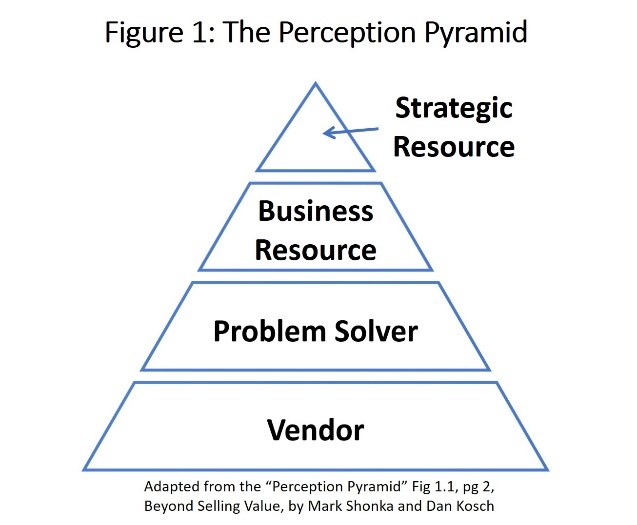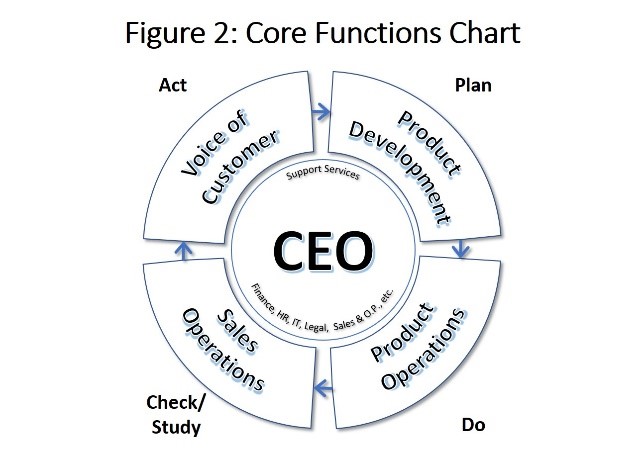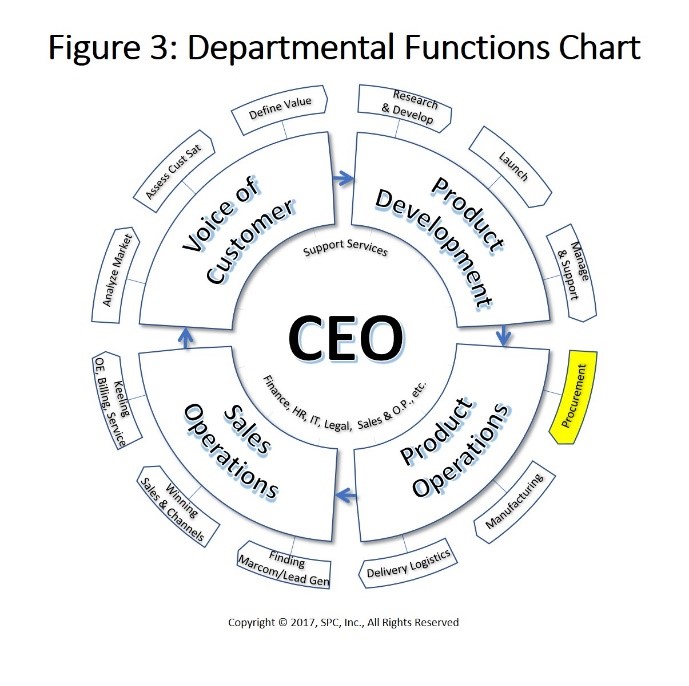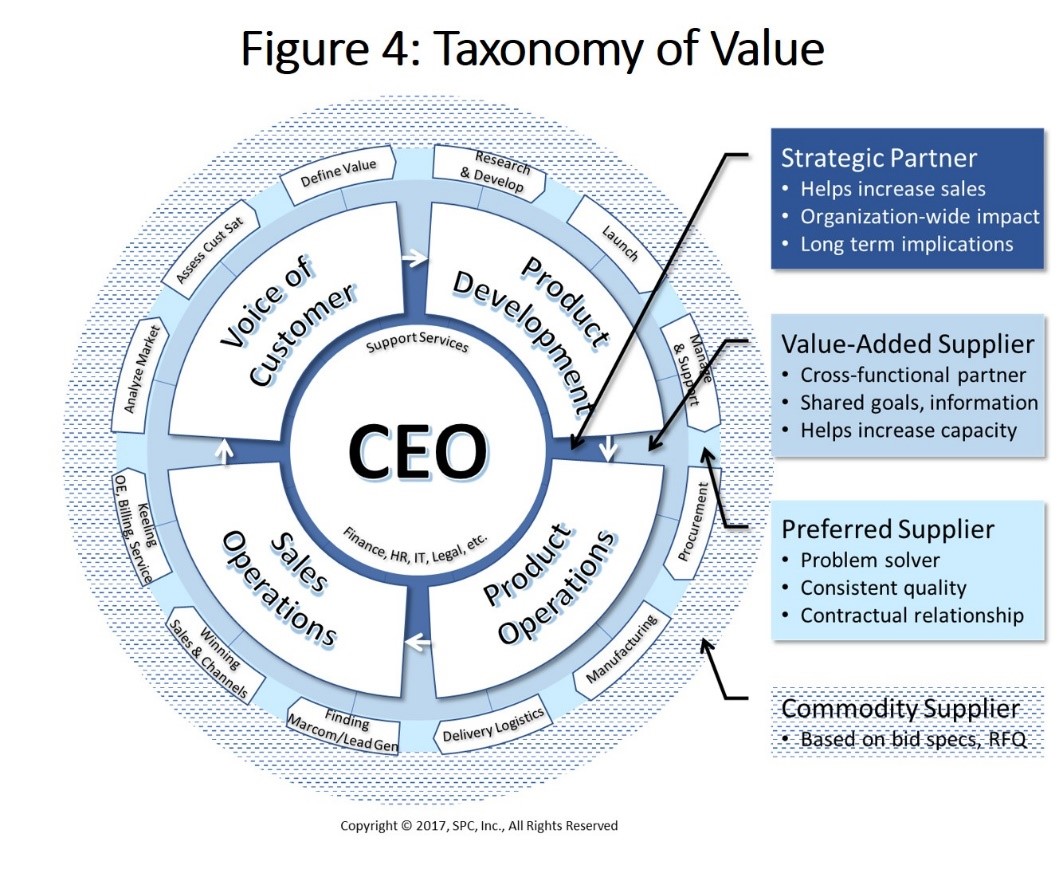SPIF Tip #44: Improving Your Value Proposition Requires the Whole Company
 Professional B2B salesmanship
Professional B2B salesmanship
is a noble endeavor. We don’t celebrate it often enough!
Great salesmanship helps people to do things they should do, and would not otherwise do. It requires the ability to listen and develop relationships at all levels of an organization. It requires facing facts, and overcoming adversity.
Most importantly, it requires earning enough trust and respect that, in its highest form, people see your company as a strategic partner, and are willing to pay for this privilege.
Obviously, these are valuable and inspiring skills, as long as the perception of value and the delivery of it are aligned.
Figure 1 is a typical depiction of a customer’s perception of a seller’s value from a well-known (and excellent) professional B2B sales training course.* Plenty of companies would love to be anything but a “Vendor”! Unfortunately, it takes more than an announcement and some sales training to become a “problem solver”, much less a “strategic resource”.
What, exactly, is required to be perceived as a problem solver instead of a vendor? What does it take to earn “strategic resource status”? This SPIF Tip will clarify these issues. It will include B2B examples of going through each of the levels. As a result, you’ll be better able to identify the most important value propositions for your customers.
People inside companies struggle to find the best ways of solving their problems. Good salesmanship helps them solve their problems faster and with less risk. That’s why they respond to it (though they don’t experience it very often).
One reason good salesmanship is so rare is this. Most salespeople have never held the jobs of the people they are selling to. It can be hard for salespeople to grasp the problems their prospects are struggling with.
Fortunately, a company can be understood as a form of experiment. If they are to survive and thrive, they must continually perform all the functions required in an experiment. These functions correspond to the Deming Management Cycle (see Figure 2):
- (Plan) Decide what products and services the market wants
- (Do) Figure out how to produce the products and deliver the services,
- (Check/Study) Offer them to customers in the best possible manner, and
- (Act) Learn from their customer’s responses
 These core functions comprise an ideal value stream that can be described as Product Development, Product Operations, Sales Operations, and Voice of Customer. These are the bare minimum. Omit any one and the business cannot survive. Every department in the business should be aligned to support these functions.
These core functions comprise an ideal value stream that can be described as Product Development, Product Operations, Sales Operations, and Voice of Customer. These are the bare minimum. Omit any one and the business cannot survive. Every department in the business should be aligned to support these functions.
Of course, Finance, HR, IT, Legal, and other “shared services” are functions as well. However, they exist only to the extent they enable the four primary functions.
A framework like this helps salespeople gain a perspective of what departments they typically call on “should” be trying to do. Of course, not all prospects or customers are as aligned as they should be. For example, most companies have no departments “officially” responsible for learning what customers want. Issues like this can provide clues for how you might be more valuable to them.
Applying the Core Function Chart
Here is a useful exercise for you and your sales and marketing team:
- Make a list of the primary customer departments your company deals with.
- Locate these departments around the four core functions, and highlight them.
- Fill in the gaps around the core – what are the departments you normally do not call on?
When you are finished, you’ll have a diagram something like Figure 3. You don’t need three departments for each goal. There can be any number of departments.
 Now, suppose you are a distributor of electronic components to manufacturers of devices such as HVAC systems, or medical devices.
Now, suppose you are a distributor of electronic components to manufacturers of devices such as HVAC systems, or medical devices.
The primary department you deal with is probably purchasing. The agents who buy such components are typically over-worked and under-paid, especially when problems crop up (as they do in all industries). You have a typical vendor relationship – you bid on the RFQ spec for the opportunity to supply the commodity. Your life is one of constant cold calls, looking for opportunities to bid on these low margin transactions.
You are challenged if you want to do more for your customers (and get paid more). What else could you do that would be valuable for them? Once you can figure that out, the problem is getting their attention in a way that helps them see that potential.
From Commodity Vendor to Preferred Supplier
One of my clients had a situation like this. Despite having proven their expertise at solving a myriad of supply problems, customers still saw them as merely a vendor. After nearly a year of experimentation, their sales team came up with answers to both of the questions above. The new sales process eliminated unlikely prospects, and enabled the remaining, likely prospects to realize a compelling new value proposition that had been right under their noses all along.
The proof? An increased rate of referrals to their managers to discuss the potential for their specific products. The new offer saved the customer money while simultaneously reducing their labor and risk. It also involved a contractual relationship that assured larger order volumes over a longer time-period.
This new relationship required more than just sales skills. The owner of the company had invested wisely over the years in proprietary software that made it easier for his team to deliver on the value-added services. This capability, plus the ability to sell it, is his key to consistently moving from the status of “Vendor” to one of “Preferred Supplier.” As Figure 4 shows, the deeper, and more cross-functional your impact, the higher your potential value.
From Preferred Supplier to Value-Added Supplier
Companies that need machine tools often have difficult dimensional tolerances, or use alloys that are hard to work with. A machine tool client earned Preferred Supplier status with some of its customers because of their ability to customize their machines with high build quality. However, this constant customization of its products made manufacturing and supporting the machines more difficult. Further, some competitors catching up.
Fortunately, a few years ago, the company initiated a standardization and simplification strategy. New controls and software technology made some radical machine designs possible. The same machine could be adapted to variations in customer requirements, while simultaneously increasing quality, while reducing cycle time, tool wear, and floor space. They simplified machine maintenance, diagnosed technical problems, and improved operator training.
These new product lines impacted their customer’s product developers and maintenance departments as well as their manufacturing engineering departments. Their salespeople faced a similar problem to the distributor above: Their customers didn’t see them in this light. They needed a way to get the customer’s attention in a way that helped them see these potentials.
They created a web page enabling interested prospects to enter pertinent part specifications, volumes, and maintenance costs. In return, the prospects received a comparison of the “cost per part produced” with the new machines versus that of three of their biggest competitors, along with a summary of start-up, change-over, and maintenance benefits.
Prospects entering their sales funnels through these web pages were ready for a more strategic conversation. By streamlining and simplifying some of the customer’s product development as well as their manufacturing operations, the customer’s perception of value was increased.
From Value Added Supplier to Strategic Partner
A beverage service retailer needed to give their customers a consistent product regardless of where in the world their stores were located. Their equipment engineers believed they needed to equip all stores with the same comprehensive water filtration and treatment equipment. My client, a well-known participant in the industry won the business by proving them wrong.
They helped the customer create a water quality specification, and demonstrated the ability to diagnose water quality at each location. Why install expensive reverse-osmosis machines if they weren’t necessary in every locale? Configuring only the equipment required for each site simultaneously saved millions of dollars in equipment and maintenance costs at the stores, while also improving the customer’s experience (which increased sales).
Conclusion
Although each case requires expert salesmanship, sales skills alone can’t do the job. Knowledge of customer’s problems is a prerequisite. Sellers, whose time is always limited, need ways to measure and prioritize the highest quality prospects. They need ways to make their case within each specific customer’s context. Doing so often requires the Internet or other marketing mediums (in addition to face to face conversations).
Further, they need the ability (and the time) to compare and contrast each other’s experiences so they can experiment to improve. Finally, they need confidence that the value they promise will be delivered. Making these things happen requires cooperation and insight from across the entire company.
Salesmanship should apply to the entire company, not just to the sales department.
What stories have you heard about how companies create value for customers? Please write about them in the comment section below.
* Adapted from the “Perception Pyramid” Fig 1.1, pg 2, Beyond Selling Value, by Mark Shonka and Dan Kosch


